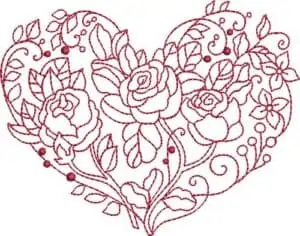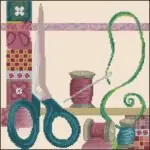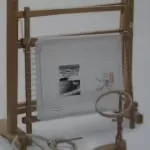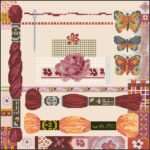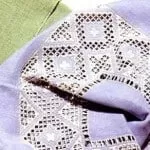Redwork Embroidery Techniques. How do you do Redwork embroidery?
Once you have the necessary tools and supplies, choose the design that you’d like to stitch. The first
step in the embroidery process is to transfer the design from paper onto your fabric.
Enlarging and Reducing Patterns
The designs can also be resized to fit many other uses. A copy machine with enlarging and reducing capabilities makes this process easy. Your local copy store or printer can provide this service.
Transferring the Pattern
Once the pattern is the desired size, it needs to be transferred to fabric. Since redwork is done on white fabric, tracing is the easiest method. Lay the fabric over the pattern, and trace the lines. A light box, available at craft stores, will make seeing the lines through the fabric easier. An inexpensive version of a light box is made for children, and is available in the craft department of toy stores for less than $10. A sunny window works, but it never fails that you’ll want to transfer a pattern at night. If you have a glass coffee table, you can put a lamp
underneath to improvise a light table.
Marking the Design
Whatever instrument you use for marking, it must produce a very fine line, and either wash out entirely,
or be entirely permanent (not bleed). I recommend a very sharp pencil with a hard lead. It makes a very
fine line, which is completely covered by the embroidery, and washes out cleanly.
“Disappearing” blue or purple ink markers are favored by some, but I find that they produce quite a fat line that is difficult to cover entirely. In addition, the chemicals in some of these pens may cause the lines to reappear as a yellow or brown line years down the road. Permanent micro-point pens work well for some. I have trouble with these bleeding, both as they mark, and later when they are washed. Other options are carbon paper, and the similar, waxy transfer paper. They are placed over the fabric, and transfer pigment to the fabric when you
write on the paper. They tend to smudge onto white fabric, so I use them only when the fabric is too heavy to see through for tracing.
Centering the Design
I generally tend to “eyeball” my designs when centering, rather than measuring precisely. Since some of the designs are slightly asymmetrical in themselves, I feel that placing them so that they are slightly off-center is actually more visually pleasing and tends to balance the asymmetry of the embroidery design. However, there are crosshatch marks in the patterns so that you can center the design exactly if you prefer.
To center a design on your fabric, fold the fabric in half and make a crease in the center. Fold it in half in the opposite direction and make another small crease in the center. Line this center point up with the crosshatch mark of the pattern when tracing. Mark the center point very lightly with pencil and use that later on when trimming and squaring up blocks.
See the first part Redwork Embroidery


